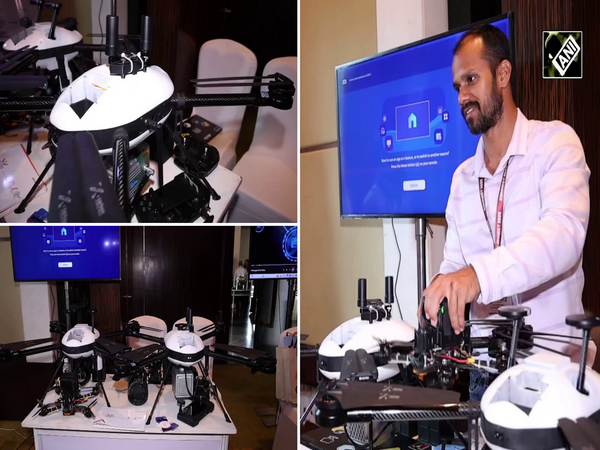China's PLA Navy launches its third aircraft carrier
Jun 22, 2022

Hong Kong, June 22 : China's navy, called the People's Liberation Army Navy (PLAN), celebrated the launch of its third aircraft carrier in a ceremony in Shanghai on 17 June. She is China's third carrier, but its second built entirely in China.
This vessel - with a flight deck that is approximately 320m long and almost 80m wide according to satellite imagery estimates - is referred to as a Type 003 carrier. A short ceremony took place to mark the occasion, but festivities appeared to be at a minimum, probably because of strict COVID protocols.
The Type 003 follows on from the Type 001 Liaoning - which was acquired second-hand and incomplete from Ukraine before being refurbished and commissioned on 25 September 2012 - and Shandong, China's first indigenously built Type 002 carrier that entered PLAN service on 17 December 2019.
However, the ceremony at the Jiangnan Shipyard threw up the name of the new aircraft carrier, which had been the source of considerable speculation; she will be called Fujian, the name of a coastal province of China that faces Taiwan. This is perhaps symbolic, for Chairman Xi Jinping and his Chinese Communist Party cohorts want nothing more than to threaten and eventually conquer Taiwan, enfolding it into Mainland China's proud bosom.
Chinese media, quoting officials, said Fujian displaces "more than 80,000 tonnes", with some observers suggesting her full-load displacement could approach 90,000 tonnes or more. Whatever her true displacement is, the Type 003 is considerably heavier than the preceding Type 001 and 002, and she is actually the first foreign carrier to approach the size and weight of American supercarriers. By comparison, the current Gerard F. Ford class of the US Navy (USN) displaces 100,000 tonnes and is 332.8m long.
After her launch, this Chinese carrier was moved to a nearby dock where fitting-out work will occur. Mooring and then sea trials will follow before she is inducted into the PLAN under the pennant number CV-18. This process will take some time, especially if another COVID-19 outbreak occurs like it did earlier this year and caused restrictive lockdowns in Shanghai.
Nonetheless, the US Pentagon stated in its most recent report on China's military that this "carrier is projected to be operational by 2024, with additional carriers to follow". As already mentioned, Fujian is China's second indigenous carrier. Apart from her larger size and displacement, there is another important distinction between her and her predecessors. This point of difference is that the Type 003 is equipped with catapults to help launch aircraft from the flight deck. In technical terms, this is called a catapult-assisted take-off but arrested recovery (CATOBAR) configuration.
By contrast, the Type 001 and 002 carriers featured a ski jump on the bow rather than catapults for aircraft operations. This ramp at the front of the ship allows fighters to get into the air without any need for a catapult. However, one disadvantage of this classic Soviet configuration is that heavier aircraft struggle to get aloft, affecting how well-armed and well-fueled fighters are when they launch.
Not only has China departed from its short tradition of ski jump-equipped aircraft carriers by employing catapults, but it has chosen catapults that are electromagnetically powered rather than traditional steam catapults.
The vast majority of USN carriers, its ten Nimitz-class vessels, employ four steam catapults. It is only the newer Ford-class carrier (of which only one is in service so far) that also utilizes the same electromagnetic aircraft launch system (EMALS).
Although this was known by analysts based on satellite imagery of Fujian during her construction in Shanghai, the adoption of EMALS means that the PLAN has completely bypassed steam catapults and gone straight to EMALS in something of a generational leap. Two electromagnetic catapults are on the Type 003's bow and one on her waist.
In comparison, all USN carriers have four catapults, a configuration that permits faster rates of aircraft sorties. Although both current American and Chinese aircraft carriers features EMALS, there is a critical difference between them. Whereas the Ford class uses nuclear propulsion, China's Type 003 is still conventionally powered by regular engines. EMALS might offer the advantage of taking up less space in the ship, and having a higher aircraft launch rate, but it does require considerable electricity generation capacity.
To shift aircraft to and from the hangar deck, the Type 003 has two elevators on the starboard side, and none on the port. This is fewer than the Ford class's three elevators, which might affect the speed of aircraft sorties in some situations.
Where the Fujian will end up being based is still a matter of conjecture, but Hainan Island is perhaps the most likely location. A massive new dry dock has been constructed at the Sanya Naval Base on Hainan, and it is large enough to accommodate a Type 003-sized vessel. This suggests that the Fujian could be well supported from that base.
The first carrier, Liaoning, belongs to the PLAN's Northern Theater Navy, while Shandong is assigned to the Southern Theater Navy. Fujian could therefore join Shandong. Another hint that this might be so is that Lingshui Air Base on Hainan is being upgraded, as this land-based facility would be used by PLAN carrier wings when not aboard carriers.
Another interesting and important question to ask is how many aircraft carriers does China aspire to?
It is clear that the PLAN will not be satisfied with just three vessels. Professor Collin Koh, research fellow at the Maritime Security Programme at the S. Rajaratnam School of International Studies in Singapore, earlier told ANI: "If you look at it from a technical perspective, if you want at least one strike group to be ready at all times, then you probably need at least three. Typically, you're talking about a year for a maintenance, repair and overhaul for a major refit ... So, three minimum to get an operational group at any time 24/7."
However, China would surely want more than one carrier available at any one time. So this will require more carriers to be built. Most estimates by experts vary between four and six vessels. Certainly, six carrier strike groups would give the PLAN's three fleets a total of two carriers each.
As China grows in confidence in its design and operation of carriers, it will doubtlessly envisage possessing nuclear-powered carriers too, just like the USA does. Nuclear propulsion gives almost unlimited endurance and a large source of power. Given her size and displacement, the Type 003 will carry more aircraft than China's first two carriers.
The Pentagon report thus stated: "This design will enable it to support additional fighter aircraft, fixed-wing early-warning aircraft, and more rapid flight operations and thus extend the reach and effectiveness of its carrier-based strike aircraft."
What aircraft are we likely to see aboard Fujian? The staple aboard the Type 001 and 002 are J-15 fighters, and that will be the case with the Type 003 too. The PLA has been developing a catapult-launched fighter variant known as the J-15T, which will presumably be ready for service the same time as Fujian is.
China is also developing a twin-seat electronic attack variant of the J-15 aircraft that is known as the J-15D. Thus, J-15s will be able to operate equally from China's three carrier types. However, in years to come, the old and heavy J-15 that is based on a past-generation Russian Su-33 will be supplemented by a new Chinese carrier-based fighter. Tentatively called the J-35 (or J-31), the new fighter is based on the FC-31 that was created by the Shenyang Aircraft Corporation. This new twin-engine fighter type achieved its maiden flight last year.
China is also developing the KJ-600 airborne early-warning (AEW) aircraft for carrier operations. The KJ-600 closely resembles the E-2 Hawkeye used by the USN, distinguished by a large radome mounted above the airframe. Such AEW aircraft are vital for extending the situational awareness of a carrier strike group. They can use their radar and command-and-control equipment to detect incoming threats and to vector friendly aircraft towards them.
The KJ-600, given its weight, cannot operate from China's first two ski jump-equipped carriers, but they will be capable of being launched by catapult from the Type 003 onwards. It is too early to say what a Type 003 air wing might look like, but it is possible to indulge in speculation. Potentially, up to 40 J-15 fighters, four J-15D electronic attack aircraft and four KJ-600 AEW platforms could be carried aboard. As production of the J-35 fighter ramps up, these would gradually replace a portion of the J-15s.
Furthermore, these fixed-wing aircraft would be supplemented by 12 Z-20 and three Z-8 helicopters for utility and anti-submarine warfare tasks. Nor can aircraft carriers operate in isolation. Indeed, they are nothing more than very expensive sitting ducks unless they have the full range of protective elements necessary for a carrier strike group. Unsurprisingly, the PLAN has been rapidly commissioning suitable assets such as Type 052D destroyers, Type 055 cruisers, Type 901 replenishment ships and nuclear-powered attack submarines that can defend and support carriers.
Once the Type 003 enters service in probably a couple of years' time, China will be able to deploy multiple carrier strike groups simultaneously. This offers considerable advantages in terms of power projection and creating a threat against possible adversaries.
And make no mistake, China is all about enhancing its naval power projection capability. Aircraft carriers therefore reflect China's ambition to project power far from Chinese shores. This is all in accordance with China's 2015 Defense White Paper that stated "the traditional mentality that land outweighs sea must be abandoned, and great importance has to be attached to managing the seas and oceans and protecting maritime rights and interests".
Carriers have immense prestige value, so they are important for the future image and capability of the PLAN. China already has a decade of carrier operations under its belt, as it gradually accumulates experience and gains institutional knowledge that will aid it in the future.
On the other hand, it must be remembered that carrier strike groups require an inordinate amount of investment. The PLAN will have to attain through training, and maintain through operations, a critical mass of qualified sailors and aviators.
As these large ships start to age and require more maintenance, they will also chew up vast amounts of money. However, this will not undermine China's ambition to advance its national naval power and compete head on with the USA at sea.


















